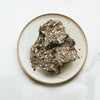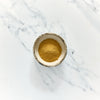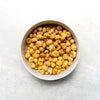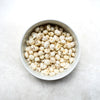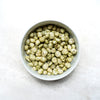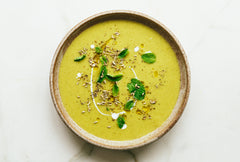
All About Anti Inflammatory Diet - How it Works, What to Eat, Benefits Etc
All you need to know about the anti-inflammatory diet
Inflammation is often associated with pain and discomfort, but did you know that certain foods can help lessen and prevent it? By carefully selecting what you eat and drink, you can harness the power of anti-inflammatory foods and make them work for you. From fatty fish to colourful fruits and veggies, the food items for reducing inflammation are plentiful. Let us learn the advantages of eating a low-inflammatory diet and what best anti-inflammatory foods to include and exclude when doing so.
Anti-inflammation: What is it?
The two types of inflammation—acute and chronic—are first defined. Sometimes inflammation seems contradictory, which can be confusing. On the one hand, inflammation promotes the body's natural ability to heal itself. This type of inflammation is referred to as acute inflammation, and it is beneficial to the body. When you have an infection or injury, the immune system releases white blood cells and chemicals to fight off the infection or repair damaged tissue. When inflammation lasts for a long time, even at low levels, it may become dangerous.
Chronic inflammation affects the body gradually by damaging cells, taxing the immune system excessively, and causing an imbalance that can result in long-term health problems. Chronic inflammation is like a small fire burning inside the body that, over time, gets stoked and encouraged by other irritants. Inflammation has the potential to harm healthy tissues even when there is no infection or injury present.
What foods are anti-inflammatory foods?
Although the anti-inflammatory foods list does not restrict calories, it may help people lose weight because it places a high priority on whole, unprocessed foods and low-calorie versions of common foods. Depending on gender and level of activity, the recommendations call for consuming between 2,000 and 3,000 calories per day, with men and more active people needing more calories and women and less active people needing fewer.
With an emphasis on including carbohydrates, fat, and protein in every meal, the anti-inflammatory diet food list suggests that 40 to 50 percent of daily calories come from carbohydrates, 30 percent from fat, and 20 to 30 percent from protein.
The majority of the daily carbohydrates consumed on the anti-inflammatory diet plan should come from fruits and vegetables. To add bulk and satiety to this category, consume beans and whole grains (not whole wheat flour).
Example food items: Homemade Banana Cake, Apricot and Olive Tagine
The good fats to eat as part of an anti-inflammatory diet plan include nuts, seeds, avocados, and extra-virgin olive oil. Saturated fats, such as those derived from animals and those that solidify at room temperature, ought to be consumed in moderation. Focus on including omega-3 fatty acids from this group of polyunsaturated fats, which also includes fats that are liquid at room temperature and both omega-6 and omega-3 fatty acids.
Example food items: Fried Rice with Tofu, Edamame and Sweetcorn
On the anti-inflammatory breakfast, lean protein sources and plant-based foods are encouraged. Fish, particularly fish high in omega-3 fatty acids, and beans, particularly soybeans and whole soy products, are advised. Reduce your intake of animal protein and steer clear of red meat.
Example food items: Mung Mushroom Bolognese
The anti-inflammatory diet also recommends that the timing of your meals is crucial. According to the studies, calories should be consumed within a 10-hour window, with the following 13 hours serving as a "fasting period." He contends that the body can repair cells, rebalance its immune system, and replenish its antioxidant reserves during this fasting period.
To whom will this diet be helpful?
People who have inflammation that is chronic and low-grade which never truly goes away. It is the antithesis of "good" inflammation and may harm DNA. This is especially troubling for people who are receiving treatment for a chronic illness because the underlying chronic inflammation may actually worsen the condition.
The good news is that we have control over many of these risk factors for chronic inflammation and chronic disease. Eating a diet rich in anti-inflammatory foods is one of the simplest and most accessible ways with foods that fight inflammation.
What to Eat?
It's crucial to consider your diet as a whole rather than focusing on specific foods. Instead of picking just a few particular foods to reduce inflammation, it's important to concentrate on your overall eating pattern. In light of this, we examine five food categories that are crucial to a non-inflammatory foods diet, as well as the qualities of each that have been supported by research and the opinions of experts.
The term "cruciferous vegetables" refers to a group of plants that includes cabbage, cauliflower, broccoli, Brussels sprouts, kale, arugula, collard greens, and even wasabi. Spirulina Thai Green Curry, Creamy Mushroom Spinach Risotto, are among the dishes that are readily accessible.
You might prefer dishes like Mung Mushroom Bolognese, Apricot and Olive Tagine, Miso Stew that contain beans and chickpeas.
You should not pass up the healthier dessert option of Homemade Banana Cake, which will provide you with the goodness of bananas, you can also add some berries if you want to.
To help reduce inflammation, it's important to include a variety of herbs and spices like turmeric, garlic, ginger, and cinnamon, and you can also try Ayurvedic Kitchari, Ayurvedic Rasam.
An excellent dietary source of omega-threes and lean protein is fatty seafood like salmon, trout, albacore tuna, Atlantic herring, Atlantic mackerel, anchovies, sardines, and even mussels.
What not to Eat?
Generally speaking, it is best to adopt a positive outlook and include as many anti-inflammatory, whole foods as you can in your diet to weed out the inflammatory foods. Recognizing the foods that cause inflammation the most, however, and limiting them in your diet, is also beneficial.
Cane sugar, granulated sugar, powdered sugar, brown sugar, high fructose corn syrup, and a long list of other refined sugars are among them.
The majority of fast food items, packaged foods, and ingredients made in factories are processed or ultra-processed.
Avoid white flour, white rice, and pasta-based products, and look for the word "enriched" on labels.
Trans fats are frequently found in processed foods, fried foods, packaged snacks, baked goods, shortening, and margarine.
Take good care of your body and yourself by engaging in daily activities that will lower inflammation. It's crucial to collaborate with your doctor to create the best treatment plan if you or someone you love has a chronic illness. To meet your needs and preferences with respect to an anti-inflammatory diet, feel free to visit Foodhak.
You can enjoy a fantastic 25% discount on your first four orders by using the code FOODHAK25 at checkout.
Also read: Anti-Inflammatory Foods, Anti-Inflammatory Diet Meal Plan, Manage disease with Anti-Inflammatory diet

